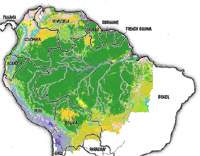Reflecting environmental conditions as well as past human influence, the Amazon is made up of a mosaic of ecosystems and vegetation types including rainforests, seasonal forests, deciduous forests, flooded forests, andsavannas. The basin is drained by the Amazon River, the world's largest river in terms of discharge, and the second longest river in the world after the Nile. The river is made up of over 1,100 tributaries, 17 of which are longer than 1000 miles, and two of which (the Negro and the Madeira) are larger, in terms of volume, than the Congo (formerly the Zaire) river. The river system is the lifeline of the forest and its history plays an important part in the development of its rainforests.
HISTORY
|
About ten million years ago, waters worked through the sandstone to the west and the Amazon began to flow eastward. At this time the Amazon rainforest was born. During the Ice Age, sea levels dropped and the great Amazon lake rapidly drained and became a river. Three million years later, the ocean level receded enough to expose the Central American isthmus and allow mass migration of mammal species between the Americas.
The Ice Ages caused tropical rainforest around the world to retreat. Although debated, it is believed that much of the Amazon reverted to savanna and montane forest (see chapter 3-Ice Ages and Glaciation). Savanna divided patches of rainforest into "islands" and separated existing species for periods long enough to allow genetic differentiation (a similar rainforest retreat took place in Africa. Delta core samples suggest that even the mighty Congo watershed was void of rainforest at this time). When the ice ages ended, the forest was again joined and the species that were once one had diverged significantly enough to be constitute designation as separate species, adding to the tremendous diversity of the region. About 6000 years ago, sea levels rose about 130 meters, once again causing the river to be inundated like a long, giant freshwater lake.
THE AMAZON RIVER TODAY
Today the Amazon River is the most voluminous river on Earth, eleven times the volume of the Mississippi, and drains an area equivalent in size to the United States. During the high water season, the river's mouth may be 300 miles wide and every day up to 500 billion cubic feet of water (5,787,037 cubic feet/sec) flow into the Atlantic. For reference, the Amazon's daily freshwater discharge into the Atlantic is enough to supply New York City's freshwater needs for nine years. The force of the current -- from sheer water volume alone -- causes Amazon River water to continue flowing 125 miles out to sea before mixing with Atlantic salt water. Early sailors could drink freshwater out of the ocean before sighting the South American continent.
The river current carries tons of suspended sediment all the way from the Andes and gives the river a characteristic muddy whitewater appearance. It is calculated that 106 million cubic feet of suspended sediment are swept into the ocean each day. The result from the silt deposited at the mouth of the Amazon is Majaro island, a river island about the size of Switzerland.
THE AMAZON RAINFOREST
While the Amazon Basin is home to the world's largest tropical rainforest, the region consists of a number of ecosystems ranging from natural savanna to swamps. Even the rainforest itself is highly variable, tree diversity and structure varying depending on soil type, history, drainage, elevation, and other factors. This is discussed at greater length in the rainforest ecology section.
THE CHANGING AMAZON
|
This transition from a remote backwater to a cog in the global economy has resulted in large-scale deforestation and forest degradation in the Amazon — more than 1.4 million hectares of forest have been cleared since the 1970s. An even larger area has been affected by selective logging and forest fires.
Conversion for cattle grazing is the biggest single direct driver of deforestation. In Brazil, more than 60 percent of cleared land ends up as pasture, most of which has low productivity, supporting less than one head per hectare. Across much of the Amazon, the primary objective for cattle ranching is to establish land claims, rather than produce beef or leather. But market-oriented cattle production has nonetheless expanded rapidly during the past decade.
Industrial agricultural production, especially soy farms, has also been an important driver of deforestation since the early 1990s. However since 2006 the Brazil soy industry has had a moratorium on new forest clearing for soy. The moratorium was a direct result of a Greenpeace campaign.
Mining, subsistence agriculture, dams, urban expansion, agricultural fires, and timber plantations also result in significant forest loss in the Amazon. Logging is the primary driver of forest disturbance and studies have shown that logged-over forests — even when selectively harvested — have a much higher likelihood of eventual deforestation.Logging roads grant access to farmers and ranchers to previous inaccessible forest areas.
Deforestation isn't the only reason the Amazon is changing. Global climate change is having major impacts on the Amazon rainforest. Higher temperatures in the tropical Atlantic reduce rainfall across large extents of the Amazon, causing drought and increasing the susceptibility of the rainforest to fire. Computer models suggest that if current rates of warming continue, much of the Amazon could transition from rainforest to savanna, especially in the southern parts of the region. Such a shift could have dramatic economic and ecological impacts, including affecting rainfall that currently feeds regions that generate 70 percent of South America's GDP and triggering enormous carbon emissions from forest die-off. These emissions could further worsen climate change.




